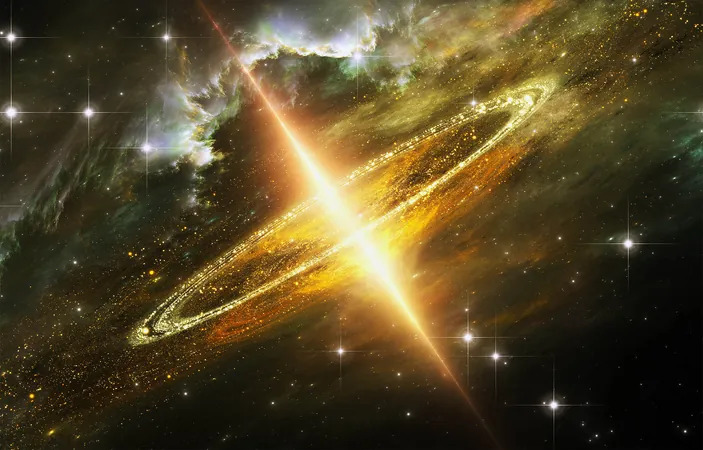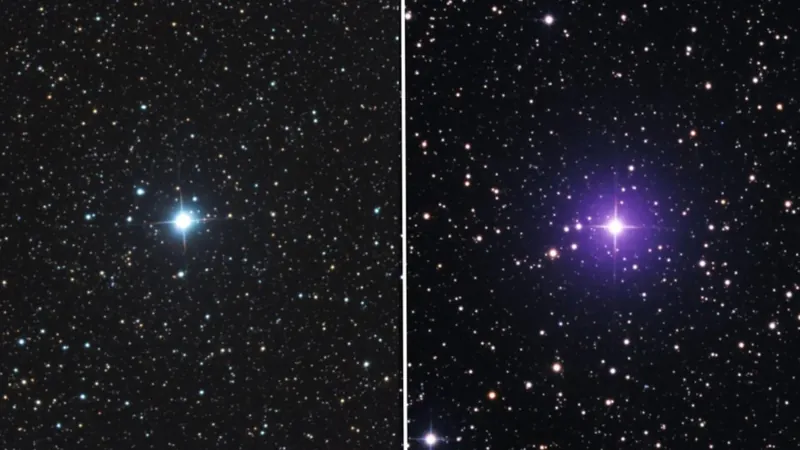
Astronomers Witness a Galaxy Awakening in Real-Time
2025-05-24
Author: Sarah
A Cosmic Alert Like No Other
In a groundbreaking cosmic event, astronomers utilizing the Zwicky Transient Facility's sophisticated wide-field camera captured the incredible moment a distant galaxy 'turned on its lights.' With the ability to scan hundreds of exposures every night, the facility quickly identifies new celestial happenings, sending alerts to astronomers within seconds of discovery.
The Star of the Show: SDSS1335+0728
In December 2019, an alert directed attention to SDSS1335+0728, an unassuming spiral galaxy nestled in the Virgo constellation, approximately 300 million light-years away. For over two decades, the galaxy’s core had been dormant—until suddenly it brightened dramatically, causing a stir among researchers as they hypothesized whether they were witnessing a star being torn apart or a black hole enjoying its first meal.
An Ongoing Mystery
Contrary to typical cosmic bursts, the brightness of SDSS1335+0728 has not subsided even after four years. This extended luminosity sets it apart from typical supernovae and tidal disruption events, placing it in a nebulous category of cosmic phenomena. Paula Sánchez Sáez, lead author of the study, remarked on the unexpected nature of this event, igniting a global effort to decode its origins.
Classifying Cosmic Events
Astronomers categorize nuclear flares into various types, including tidal disruption events where a star ventures too close to the black hole, turning on active galactic nuclei, and others that transition between bright and dim states. The classification relies heavily on timing, color, and spectra, with sky surveys like ZTF and the upcoming LSST producing a deluge of data, necessitating human analysis alongside automated systems.
Unveiling the Mystery of SDSS1335+0728
Astronomers utilized advanced instruments, such as the X-shooter spectrograph at the European Southern Observatory’s Very Large Telescope, to monitor the galaxy. Infrared and ultraviolet emissions surged sharply, and by February 2024, X-rays began to illuminate the galaxy's core for the first time. Researchers detected broad emission lines, indicative of fast-moving gas near the black hole, leading Sanchez Sáez to call this behavior unprecedented.
A Unique Cosmic Window
Unlike most supermassive black holes that have long finished their growth or appear dormant, the awakening of SDSS1335+0728 provides valuable insights into processes typically observed during the universe's infancy. This event could have significant implications for star formation and galaxy mergers, transforming it into an extraordinary laboratory for understanding galaxy evolution.
The Implications for Our Milky Way
This awakening phenomenon raises intriguing questions about our own supermassive black hole, Sagittarius A*, located at the Milky Way's core. Co-author Claudio Ricci noted the possibility that a similar event could occur in our galaxy, although the likelihood remains uncertain.
What Lies Ahead?
Ongoing research aims to gather more extensive data to determine whether this flare represents a slow tidal disruption, the birth of an accretion disk, or an entirely new type of cosmic event. The implications are vast, potentially reshaping our understanding of black hole activity and frequency in the modern universe.
A Beacon of Discovery
As astronomers prepare for a deeper dive into this cosmic mystery with future instruments like MUSE on the Very Large Telescope and the upcoming Extremely Large Telescope, SDSS1335+0728 serves as a timely reminder that the universe still holds surprises, waiting to be uncovered. With ongoing telescope surveys, more dormant giants may awaken, transforming routine observations into extraordinary discoveries.




 Brasil (PT)
Brasil (PT)
 Canada (EN)
Canada (EN)
 Chile (ES)
Chile (ES)
 Česko (CS)
Česko (CS)
 대한민국 (KO)
대한민국 (KO)
 España (ES)
España (ES)
 France (FR)
France (FR)
 Hong Kong (EN)
Hong Kong (EN)
 Italia (IT)
Italia (IT)
 日本 (JA)
日本 (JA)
 Magyarország (HU)
Magyarország (HU)
 Norge (NO)
Norge (NO)
 Polska (PL)
Polska (PL)
 Schweiz (DE)
Schweiz (DE)
 Singapore (EN)
Singapore (EN)
 Sverige (SV)
Sverige (SV)
 Suomi (FI)
Suomi (FI)
 Türkiye (TR)
Türkiye (TR)
 الإمارات العربية المتحدة (AR)
الإمارات العربية المتحدة (AR)